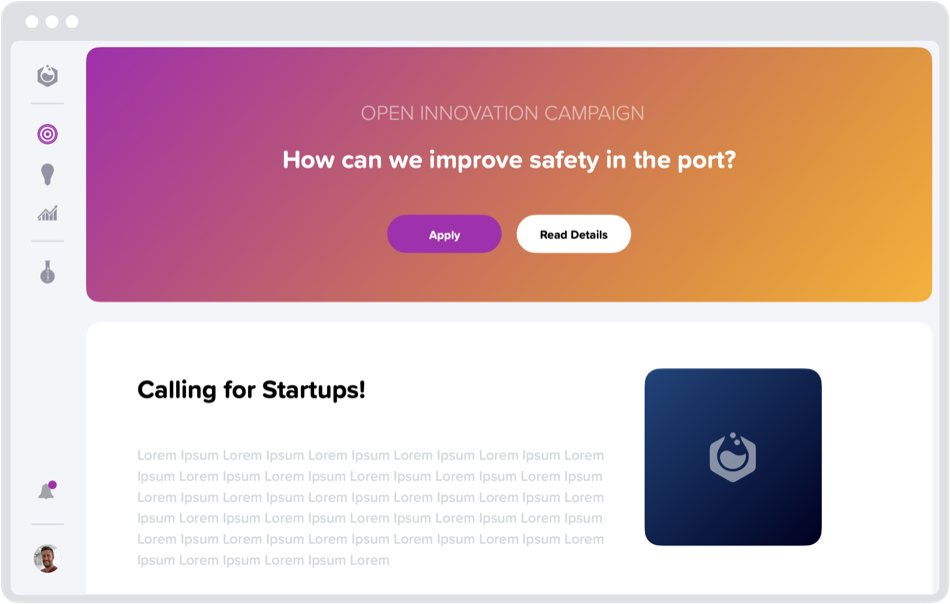
Our platform offers a comprehensive suite of tools and features designed to streamline the entire process, from idea generation to implementation, empowering companies to harness the collective intelligence of internal and external stakeholders for transformative innovation.

Complete Deliverables
Access a library of customizable templates designed to support various deliverables within the innovation process. From project plans and roadmaps to design briefs and experimentation frameworks, Yambla offers pre-designed templates that streamline the creation and execution of deliverables.
Discover More Features →

Workflow Automation
Automate the innovation workflow and streamline the process of bringing groundbreaking ideas to life. Our platform offers a range of features designed to automate structured steps and deliverables, enabling companies to drive innovation more efficiently and effectively than ever before.
Discover More Features →

Custom Branding
Yambla offers extensive support for custom branding, ensuring that your company's identity and values are reflected seamlessly throughout the innovation process. With Yambla, you can create a fully branded experience that resonates with your audience and reinforces your corporate identity.
Discover More Features →
Other Highlighted Features
Automatic Content Translation
Bridge the language gap effortlessly and go global with ease.
Custom Domain
Map the platform to your own domain for increased recognizability.
Custom App
List your own innovation app in the mobile app stores for a strong program identity.
Discover More Features →
Distinctly Us
Experience an exceptional product with even more exceptional customer service.
Open Innovation Is Just The Beginning
Fuel innovation with one flexible solution, allowing you to launch any program format effortlessly.
Discover Our Product Suite →
What is Open Innovation?
Open innovation refers to the practice of leveraging external ideas, knowledge, and resources to complement or supplement an organization's internal innovation efforts. In other words, it is a collaborative approach that involves seeking and incorporating external contributions into the innovation process.
Traditionally, innovation was seen as an internal process within a company, where research and development activities were conducted in-house, and ideas were kept confidential. However, with open innovation, organizations recognize that valuable ideas and technologies can also be found outside their boundaries, and they actively seek to engage with external stakeholders in the innovation process.
There are two main ways open innovation can be practiced:
-
Inbound Open Innovation:
Inbound open innovation focuses on bringing external knowledge, ideas, and technologies into the organization.
This can be achieved through various means, such as:
- Collaborating with external partners, such as universities, research institutions, startups, or other companies, to access their expertise and innovations.
- Participating in innovation challenges, contests, or hackathons to solicit ideas and solutions from a diverse community of problem solvers.
- Engaging with customers and users to gather insights, feedback, and ideas for new products or improvements to existing ones.
- Licensing or acquiring external technologies or intellectual property to incorporate into the organization's products or services.
-
Outbound Open Innovation:
Outbound open innovation involves leveraging the organization's internal assets, such as technologies,
patents, or expertise, and sharing them with external entities. This can lead to various benefits, such as
generating additional revenue streams, establishing strategic partnerships, or creating new market
opportunities.
- Licensing or selling intellectual property or technology to other companies.
- Collaborating with external partners to jointly develop and commercialize products or services.
- Spinning off internal projects into separate ventures or startups.
- The benefits of open innovation include access to a broader pool of ideas, reduced development costs, faster time-to-market, increased flexibility, and the potential for disruptive innovations. However, open innovation also requires effective collaboration, intellectual property management, and the establishment of trust among partners.
Many successful companies today embrace open innovation as part of their overall innovation strategy. They recognize that tapping into external knowledge and expertise can significantly enhance their ability to stay competitive and deliver novel solutions to the market.
Powering Collaborative Innovation worldwide.
Get Started Today!
Trusted by some of the world’s smartest companies










